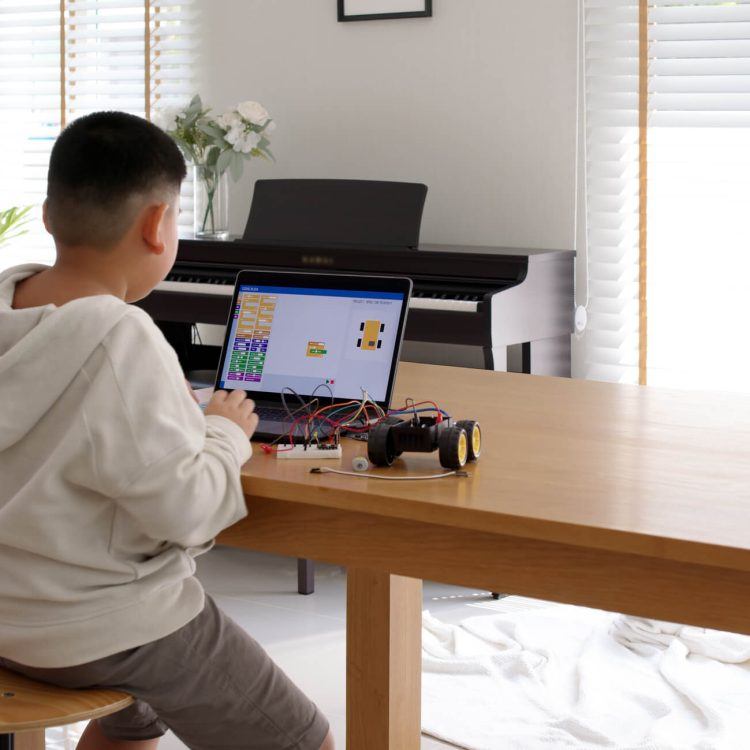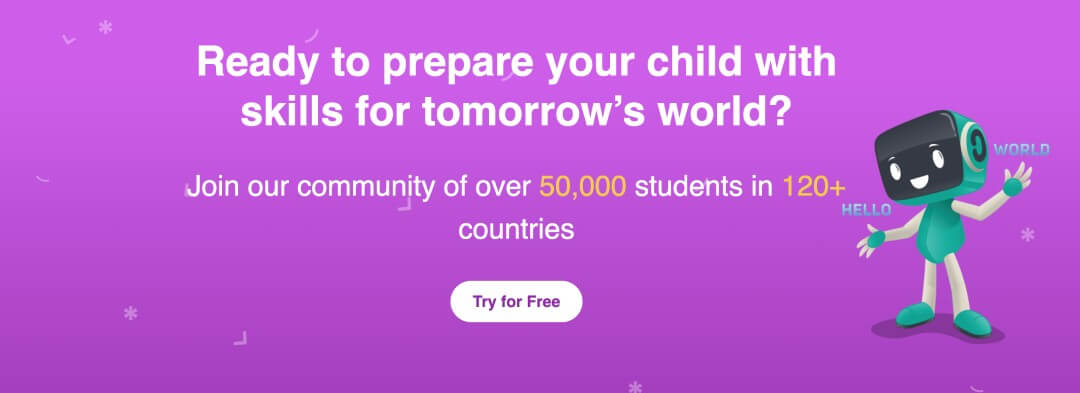“Welcome to our journey into the world of block coding, a revolutionary approach to teaching programming to kids and beginners alike. As a seasoned instructor with over a decade of experience at CodaKid, I’ve witnessed firsthand the transformative power of block coding in demystifying the complexities of programming for young minds.
In this article, we will explore what block coding is, its advantages and drawbacks, and how it’s changing the landscape of learning and development in technology. Together, we will uncover the essentials of block coding, delve into real-world examples, and highlight the tools and platforms that make programming accessible and fun for children. Join me as we decode the blocks of digital literacy and open the door to a world of creativity and innovation.” – David Dodge, CEO
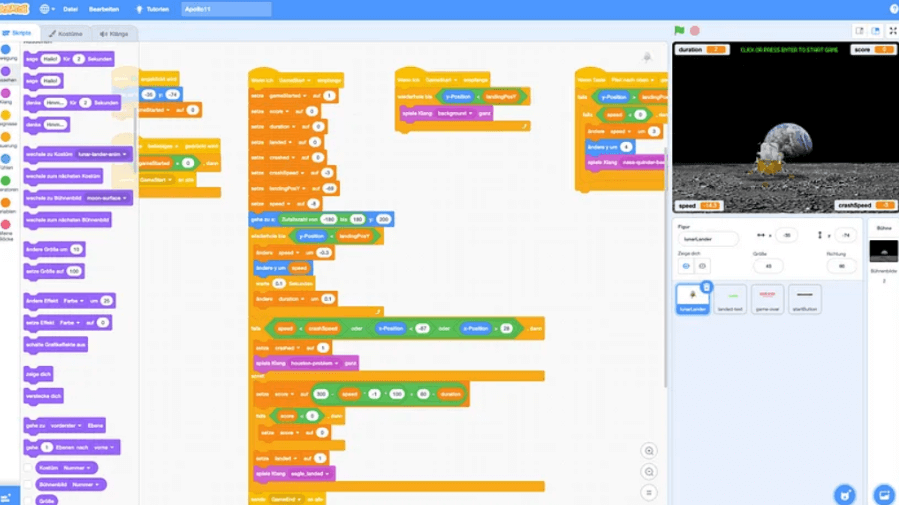
Table of Contents
What Is Block Coding? Simple Definition
Block coding, often referred to as block-based or visual programming, is a beginner-friendly method of coding that uses graphical blocks to represent code concepts. Instead of writing complex lines of code, programmers, especially young learners, can drag and drop these blocks to form sequences and create programs. Each block is designed to perform a specific function and can be connected with others like pieces of a puzzle to build functional scripts.
This intuitive method significantly lowers the barrier to entry for programming, making it an ideal starting point for children and beginners. By abstracting the syntax complexities of traditional coding languages, block coding focuses on the logic and structure of programming, fostering a deeper understanding of computational thinking.
“Through block coding, we aim to equip our students with the foundational skills necessary for future success in the digital world,” – Matthew Stinson, a product development lead at our academy.
As we delve deeper into the nuances of block coding, we’ll discover how this innovative approach is shaping the future of education and software development.

Advantages and Drawbacks of Block-Based Coding
Exploring the world of block-based coding reveals a landscape filled with opportunities and challenges. This approach to programming with blocks has transformed the way we introduce coding to the next generation, making it crucial to understand both its strengths and limitations.
Pros of Block Programming
The advantages of block programming are numerous, particularly when it comes to engaging young minds in the realm of coding. Here are a few key benefits:
- Accessibility: Block-based coding makes programming more accessible to beginners, especially children. By using coding blocks for kids, we remove the fear of syntax errors and lower the entry barrier to the world of coding.
- Understanding of Logic and Structure: Despite its simplicity, block programming offers a solid foundation for understanding the logic behind programming. It encourages problem-solving and critical thinking skills without the initial complexity of syntax.
- Engagement and Creativity: Block-based programming turns learning into a game, allowing students to explore, experiment, and express their creativity. This playful approach increases engagement and sustains interest in STEM subjects.
- Smooth Transition to Text-Based Coding: For those who start with block-based coding, the transition to traditional text-based programming languages is often smoother. Understanding the concepts without worrying about syntax enables a deeper comprehension of programming fundamentals.
“A key advantage of block-based programming languages is their ability to demystify coding concepts, making them tangible and less intimidating for young learners,” – Lauren Nguyen, Co-Founder and CEO.
Cons of Block Programming
While the benefits are significant, there are also drawbacks to consider:
- Limited Complexity: As students progress, they might find the block-based programming environment somewhat limiting. The simplicity that makes block coding appealing to beginners can restrict advanced users’ creativity and problem-solving skills.
- Over-reliance on Visual Aids: There’s a risk that learners might become too dependent on visual aids, potentially hindering their ability to write and understand traditional code.
- Transition Challenges: Some students may struggle to transition from block-based programming to text-based languages. They might find it challenging to adjust to the syntax and errors of conventional coding after starting with block programming languages.
- Perception Issues: There’s a misconception that programming with code blocks is “just for kids,” which might discourage older learners from recognizing its value as a stepping stone to more complex programming concepts.
“In navigating the transition from block coding to text-based coding, it’s crucial to gradually introduce syntax alongside block-based programming to ensure students are well-prepared for future challenges.”
Despite these challenges, block-based coding remains a powerful tool in the arsenal of educational technology, offering a balance of fun and foundational learning that prepares students for a future in digital innovation.
Related articles:
Computer Basics for Kids | Everything You Need to Know
70+ Important Coding Terms for Beginners to Get Started!
Example of Block Programming
Block coding, a revolutionary approach to learning and understanding programming concepts, simplifies coding into visually engaging, draggable blocks. This method not only makes programming accessible to beginners, especially children but also instills foundational programming logic and structure without the complexity of syntax errors.
Below, we delve into various types of code blocks commonly found in block-based programming environments. Each type serves a unique purpose, from animating characters to creating interactive stories and games. Through these examples, we’ll explore the versatility and creativity block coding offers.
Motion Blocks Coding
Motion blocks are the building blocks that bring characters to life in a digital space. Imagine a scenario where a cat sprite is programmed to move 10 steps forward when the user presses the right arrow key. This is achieved by snapping together a simple sequence of motion blocks, one specifying the event (key press) and another defining the action (move steps). A visual representation could show a cat sprite on a screen with an arrow pointing forward, accompanied by block code snippets illustrating the action.

Loops Blocks Coding
Loops are foundational to programming, allowing tasks to be repeated multiple times efficiently. In block coding, a loop block might be used to make a character dance back and forth across the screen without needing to duplicate the motion commands. For instance, a loop can be set to repeat a sequence of moves 10 times. Visually, this can be depicted by a loop block encircling blocks that represent dance moves, showing how code is simplified yet powerful.
“Loops teach children the power of iteration and efficiency in coding, skills applicable in problem-solving beyond the computer.”
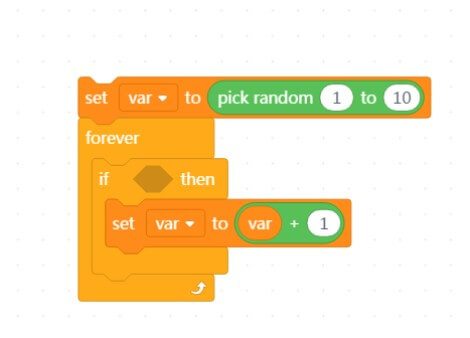
Events Blocks Coding
Events are triggers that start actions in a program, such as pressing a key, clicking the mouse, or even receiving a message from another part of the program. An event block might be used to start a game when the green flag is clicked, setting off a chain reaction of actions defined by subsequent blocks. Illustrations could demonstrate a green flag symbol alongside event blocks, highlighting the cause-and-effect nature of programming.
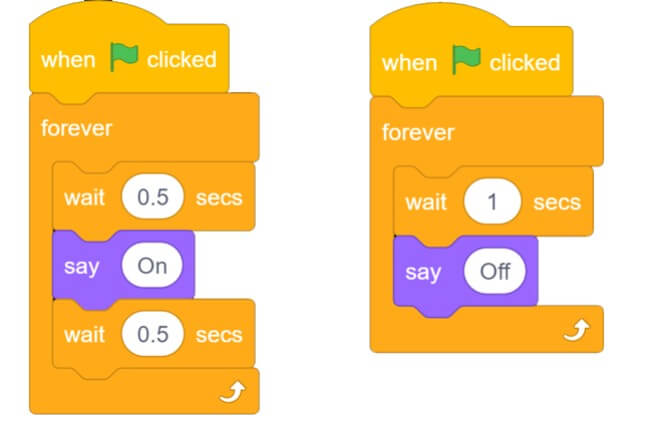
Sound Blocks Coding
Sound blocks add an auditory dimension to projects, enabling the inclusion of music, sound effects, and voice-overs. For example, a sound block could play a celebratory tune when a player scores a point. A visual could include musical notes emanating from a speaker icon, with corresponding sound blocks showcasing how different sounds are integrated into a project.
“Incorporating sound blocks enhances the sensory experience of projects, making learning even more engaging and memorable.”

Visual Effects Blocks Coding
Visual effects blocks add flair and feedback to projects, allowing creators to change the appearance of sprites through effects like brightness, color, and ghosting. An example might involve a sprite gradually becoming invisible (ghost effect) as it moves up the screen, simulating a simple magic trick. A visual could display a sprite with varying levels of transparency alongside blocks dictating these changes, illustrating the dynamic visual capabilities at a young programmer’s fingertips.
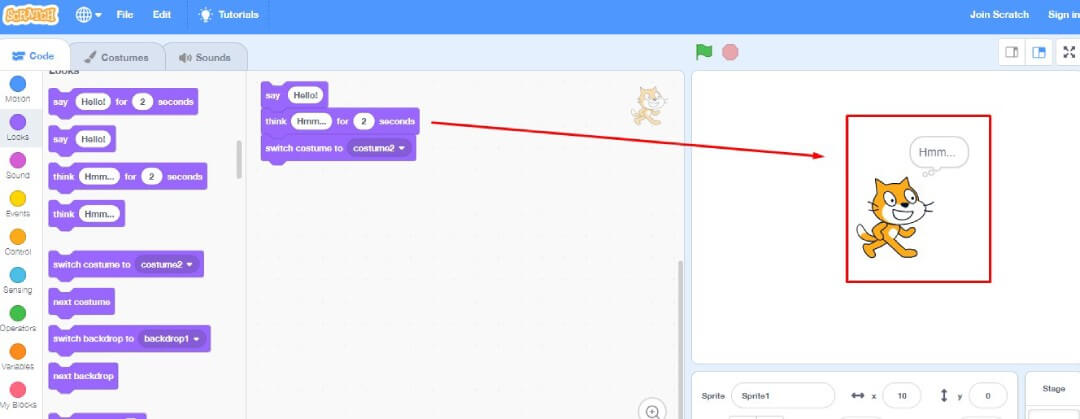
Related articles:
Scratch Sprites | Everything You Need to Know
Typing Apps for Kids | The Essential Guide
Tools and Platforms for Block Coding
In the realm of block coding, a variety of tools and platforms stand out for their unique approaches to teaching programming concepts. These resources are designed to educate and inspire creativity and problem-solving skills among young learners. Below, we explore some of the best websites, apps, and games available to teach children block-based programming fundamentals.
Websites for Teaching Children
-
Scratch
Developed by the MIT Media Lab, Scratch is arguably the most popular block coding platform, allowing children to create stories, games, and animations. Its user-friendly interface and vast community make it an excellent tool for beginners to learn coding fundamentals. Scratch empowers children by letting them share and explore projects created by peers, fostering community and collaboration.
“Scratch has transformed the way we teach coding, making it a playground for young minds to explore and create.”
-
Music Blocks
This unique platform combines music and coding, allowing children to compose music by connecting blocks that represent different musical elements. It’s an innovative way to teach mathematical concepts and logical thinking through the creation of melodies and rhythms. Music Blocks encourages a different type of creativity, showing that coding can extend beyond the screen to artistic expressions.
-
Tynker
Tynker stands as a powerful platform that facilitates the learning of coding through a visually appealing, block-based approach. It offers a vast library of courses and projects tailored to different age groups and interests, making it an ideal environment for children to begin their coding journey. With Tynker, learners can progress from simple drag-and-drop coding exercises to writing real code, providing a smooth transition to text-based programming.
Apps for Block Coding
-
Stencyl
Stencyl offers a more advanced platform for kids ready to transition from basic block coding to game development. It uses a block-snapping interface similar to Scratch but with capabilities for creating more complex games that can be published on various platforms. Stencyl is unique for its ability to introduce children to game design principles while keeping the coding accessible.
-
ScratchJr
Designed for younger children (ages 5-7), ScratchJr simplifies the Scratch experience to suit pre-readers and early readers. With a more intuitive interface and simpler blocks, it introduces the basics of programming, allowing children to tell stories and create animations. ScratchJr’s unique adaptation for younger audiences ensures that coding education can start at an early age. ScratchJr is only accessible through mobile devices which works well for younger students who have yet to develop keyboarding and mouse skills.
-
CodeVenture
CodeVenture introduces coding through interactive adventures where each level teaches a new coding concept through puzzle-solving and critical thinking. Designed for children aged 6-12, CodeVenture makes each coding lesson an exciting quest, fostering engagement and retention.
Games for Learning Block Coding
-
Adventure Code
Adventure Code takes children on a thrilling journey through mystical lands where they must use block coding to solve puzzles, overcome obstacles, and unlock secrets. By integrating coding challenges directly into the gameplay, Adventure Code promotes learning through play, making complex concepts more digestible and fun.
-
Blockly Games
Blockly Games offers a series of educational games that teach programming using a block-based approach similar to Scratch. Each game focuses on a different programming concept, from simple sequences to more complex logic and loop use. Blockly Games excels in making learning incremental and enjoyable, suitable for absolute beginners.
-
Box Island
This award-winning game teaches coding logic through the adventures of Hiro, a young explorer navigating the mysterious Box Island. Players use block coding to solve puzzles and progress through levels, learning key programming concepts along the way. Box Island stands out for its story-driven approach and beautifully designed 3D environments, making coding education visually appealing and narratively compelling.
How Block-Based Coding is Changing Learning and Development
Block-based coding is not just a revolutionary tool for introducing children to the fundamentals of programming; it’s reshaping the landscape of education and software development. This intuitive approach to coding, which simplifies complex concepts into visually understandable blocks, is making a profound impact on how young learners engage with technology and develop computational thinking skills.
In educational settings, block programming serves as a bridge between abstract problem-solving and tangible results. By allowing students to manipulate code through drag-and-drop blocks, it demystifies the process of programming, making it accessible and engaging.
“Block coding transforms the intimidating process of learning to code into a playful experience, allowing students to focus on logic and structure without getting bogged down by syntax.”
Beyond the classroom, block programming is influencing software development, particularly in the realms of game design and mobile app development. By lowering the barrier to entry for creating digital projects, block coding platforms have become incubators for innovation and creativity.
Young developers are designing games, animations, and apps that address real-world problems, tell unique stories, and express their creativity. This democratization of technology creation empowers a new generation of coders, who might not have engaged with traditional coding languages, to contribute their voices and ideas to the digital landscape.
Related articles:
7 Ways to Teach Your Kids to Become Entrepreneurs
Coding for 10-Year-Olds: A Comprehensive Guide for Parents
Study Block Programming with Us
At CodaKid, we’re at the forefront of this educational revolution, offering courses that not only teach block coding but also inspire a love for technology and innovation. Our curriculum is designed to guide students through the exciting world of block-based programming, from the basics of motion and events to the complexities of game development and app creation.
“Our courses are more than just lessons; they’re adventures that challenge students to think creatively, solve problems, and bring their digital dreams to life,” – David Dodge, Co-Founder of Codakid.com.
We believe that every child has the potential to become a creator, innovator, or entrepreneur. With block coding as a foundation, we’re committed to unlocking that potential, one line of code at a time. Whether your child is taking their first steps into programming or ready to build their own game, CodaKid has a course that can help them reach their goals.
